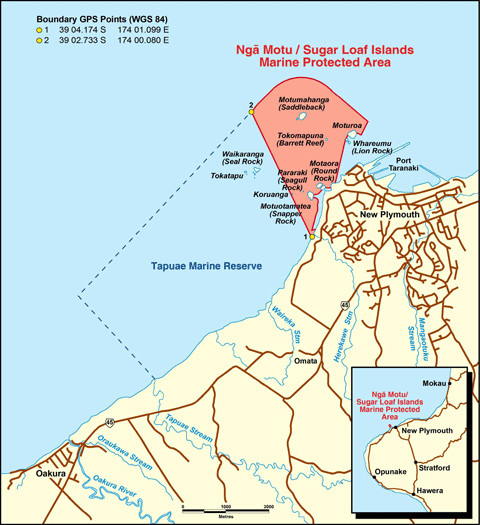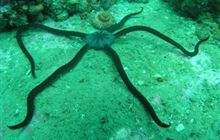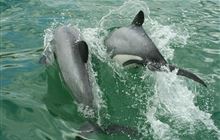Ngā Motu/Sugar Loaf Islands Marine Protected Area
Located in the Taranaki region
|
Introduction
This Marine Protected Area comprises 749 ha of seabed, foreshore and water around the Ngā Motu/Sugar Loaf Islands. It offers some great recreational opportunities.Ngā Motu/Sugar Loaf Islands Marine Protected Area borders Tapuae Marine Reserve. Be aware the rules of these adjoining areas differ. You can't fish or remove marine life or natural material within Tapuae Marine Reserve.
Find things to do and places to stay Ngā Motu/Sugar Loaf Islands Marine Protected Area
The islands and reefs in the Sugar Loaf Islands Marine Protected Area are close to Port Taranaki in New Plymouth and are a popular diving spot. The deep water is home to a variety of marine life and the scenery is spectacular. In summer and autumn underwater visibility can reach 20 metres so these are the best times to dive.
Dive shops and the New Plymouth Sports Fishing and Underwater Club regularly dive the area and can provide advice on the best locations and conditions. Divers must display a dive flag while diving to alert boat operators of their presence.
Before you dive, think DEEP:
- don’t drink alcohol
- equipment must work properly
- exercise and fitness - make sure you’re fit and healthy enough for the dive
- partner up, never dive alone.
Learn more about staying safe underwater on the Water Safety NZ website
Recreational fishing is a popular activity in the Marine Protected Area. Individual fishers are restricted to one rod with a maximum of three hooks. Set netting and long lining are banned. Species taken include kingfish, kahawai, snapper, blue cod, trevally, blue moki, sweep, red gurnard and tarakihi. Normal recreational size and bag limits apply.
Game fishing for tuna, marlin and mako shark is popular further offshore during summer and early autumn.
You cannot fish in the northern boundary of the Tapuae Marine Reserve
The Marine Protected Area borders the northern boundary of the Tapuae Marine Reserve. You cannot fish or remove marine life or natural material within the reserve.
Whether you are fishing from rocks or from a boat, always:
- do your research on the place and weather first
- wear a life jacket and communication devices
- take a friend and tell a friend
Ngā Motu/Sugar Loaf Islands Marine Protected Area borders Tapuae Marine Reserve. Be aware the rules of these adjoining areas differ. You can't fish or remove marine life or natural material within Tapuae Marine Reserve.
Read more on the NZ Fishing Rules app.
Marine Protected Area rules
- Commercial fishing, except trolling for kingfish and kahawai, is not allowed.
- Spoil dumping and activities that may disturb the foreshore and seabed are restricted. This includes anchoring by commercial vessels, mining and drilling.
- Access to the Ngā Motu/Sugar Loaf Islands is by permit only.
Central area (lower half of the North Island) fishing rules
Check fishing rules in the area before you go fishing. You need to check for:
- the set net ban in Taranaki
- closed and restricted fishing areas
- temporary closures
- other set net restrictions
- food safety closures.
Marine Protected Area location map

View a larger, print-fomatted map of the Marine Protected Area (PDF, 51K)
Boundary GPS Points (WGS 84)
- 39 04.174 S 174 01.099 E
- 39 02.733 S 174 00.080 E
Just offshore from New Plymouth is the stubble of an ancient but massive volcano much older than Mt Taranaki. Formed 1.75 million years ago, soft rock has long since been eroded away leaving a group of low sea stacks and seven islands that provide a unique semi-sheltered environment along an otherwise exposed coastline.
The Marine Protected Area comprises seabed, foreshore and water around Ngā Motu/Sugar Loaf Islands. It backs onto the northern boundary of the Tapuae Marine Reserve.
Marine environment
The subtidal marine habitats around the Ngā Motu/Sugar Loaf Islands include: spectacular canyons, caves, rock faces with crevices and overhangs, large pinnacles, boulder fields and extensive sand flats.
There are at least 89 species of fish, 33 species of encrusting sponges, 28 species of bryozoans and 9 nudibranchs.
The Ngā Motu/Sugar Loaf Islands are important for 19 species of seabirds, with approximately 10,000 seabirds nesting here. A breeding colony of New Zealand fur seals is there too.
Protection and recognition
The Sugar Loaf Islands Marine Protected Area was established in 1986 to control both fishing (under the Fisheries Act 1983) and non-fishing (under the Harbours Act 1950) activities. The formal protection of this area was supported by a traditional blessing with a tohunga (priest) placing a rahui over the area.
Concern about the areas degree of protection against oil prospecting and development led to the Sugar Loaf Islands Marine Protected Area Act 1991. The Act included a prohibition against mining.
Local Māori called the islands Ngā Motu – 'the islands', and were actively living on them when first European settlers arrived. In 1770 the guano deposits reminded James Cook of the way sugar in Europe was stored in heaps or loaves and he named the islands the Sugar Loaf Islands. In the 1820s a whaling station was established on Moturoa Island.
Contacts
| Taranaki/Egmont National Park Visitor Centre | |
|---|---|
| Phone | +64 6 756 0990 |
| egmontvc@doc.govt.nz | |
| Address | 2879 Egmont Road Egmont National Park 4386 |
| Hours | See visitor centre hours |


